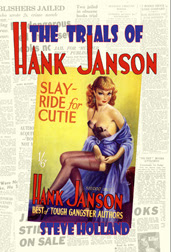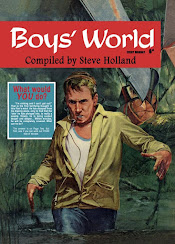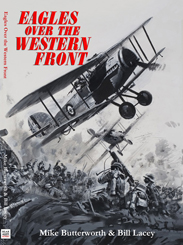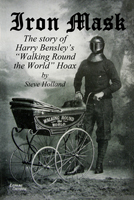Roy Bullen was a (perhaps irregular) contributor to various D. C. Thomson papers whose writing career seems to stretch to quite a few decades. I believe Roy Bullen lived in Guildford for many years, contributing to Battle Picture Library and Commando in the late 1960s and early 1970s as well as penning a strip for Buddy in the early 1980s. He seems to have later moved to the Sheffield area and published a number of books on military history.
Non-fiction
History of the 2/7th Battalion the Queen's (Royal Regiment, 1939-1946. Guildford, 1958.
Sheffield's Volunteer Armies. The roll of the Loyal Sheffield Volunteers, 1794-1795; The Sheffield Volunteer Infantry, 1803-1808. Sheffield, Sheffield & District Family History Society, 2002.
Others
The Old Days in Dore. A history of Dore, drafted by J. Hancock, edited by Roy Bullen. S. Yorkshire, Dore, R. Bullen, 1988.
In Praise of Rambling. Poetry and prose for countrygoers, compiled by Roy Bullen. Sheffield, R. Bullen, 1999.
Comic Strips
The Deserter. Battle Picture Library 354, Jul 1968, art by P. Martinez Henares.
Framed. Commando 521, Jan 1971, art by Victor de la Fuente.
The Sands of Fear. Commando 564, Jul 1971, art by Collado.
(* Commando © D. C. Thomson.)
Saturday, March 31, 2012
Friday, March 30, 2012
Comic Cuts - 30 March 2012
Blogger, in their wisdom, have made some changes behind the scenes to the various pages and panels I use to write and upload pictures each day. Although the changes were meant to be introduced across the whole blogger-sphere in April, I thought I'd stay ahead of the curve and switch over now.
I'm not sure if I approve yet. When they first tried to beta-test the new layouts I took a look and immediately switched back to the old style. Actually, I fired off a snotty comment about some of the icons they were using and criticised the layout. As is common with all big organisations making changes, they immediately ignored my feedback and went ahead with their "improvements". But I'm sure I'll get used to it... after all, when I was working on the Look and Learn blog I was using a different system entirely (Word Press) and managed to cope.
I don't think you will notice any of the changes on the pages you see, but I mention this just in case there's a glitch in the system and, one day in April, things go a bit weird for a while. Please let it not be April 1st, or everyone will think it's an elaborate joke.
Anyway, on with the news. Gwyn Evans: The Lunatic, the Lover and the Poet is almost finished. It should run to around 96 pages, A4 perfect bound and I'm waiting on one thing before going to the proofing stage. As soon as I've locked down the pages, I'll be posting the usual pre-order form over at the Bear Alley Books site. Hopefully I'll be doing this within the next week, so keep your eyes open for an announcement.
Next week I should have an announcement about some more titles coming your way from Bear Alley Books that I'm planning to release over the next few months, starting (I hope) in May.
Also coming in April... another increase in postal charges. You may have seen in the news that prices are going up by 14p for both first and second class stamps from April 30th. That's a 30% and 39% increase respectively, driven by the government's desire to sell off the Royal Mail, which is likely to happen in 2014. A lot of the newspaper coverage has been about how the increase will affect the Christmas card market, but the collecting market will be hit immediately: everything you buy from eBay or from a dealer is going to cost you more. Take Amazon's fixed price of £2.80 for delivery. The packaging I use for Pages from History costs me £1.41 as I don't order in bulk — 1 pack of 50 at a time as I don't want to have a ton of cash tied up in packaging, nor do I have the spare change to order 500 or 1,000, which is where the discounts kick in. Postage, at the moment, is £2.16, making a total of £3.57; I set the charge at £4.00 on the website because I have to add in PayPal's charges (about £1.20 per book), which I split across the cover price and the postage charged.
Back at our Amazon example: Amazon charge £2.80 but that amount isn't sent to the seller. They claw back 56p, so the dealer only gets £2.24... and if it's costing me £3.57 post & packing, I lose £1.33 on every book sold through Amazon just in postage alone. That's why the basic price of the book on Amazon is £22 rather than the £17.99 list price on the Bear Alley Books website.
I've used Amazon as an example because I have the numbers to hand, but you can apply the same to all second-hand dealers, eBay, Abe Books, etc., etc., etc. The packet rate (up to 750 grams) is increasing to a flat-rate £2.20, so packets that used to cost £1.23 will almost double.
Inevitably, the price increases will have to be passed on by all small businesses. Most of them will survive but it's a frustrating price increase, especially when it is so cynically intended to boost the profits of the Royal Mail ahead of privatisation. As, I might add, is the move to separate the Royal Mail from the Post Office, leaving the latter with a £9.5 billion pensions black hole to be sorted out by taxpayers rather than the new owners of Royal Mail.
It might seem like an equally cynical plug but if you are thinking about buying one (or more) of the books from Bear Alley, now would be the time to do it!
The last bit of Bear Alley Books news is that the hardback edition of Mean Streetmaps is now sold out! I have a couple of proof copies left over which are essentially the same as the finished version, should anyone wish to have a copy. As these are (obviously) very limited in number, and readers' last chance for a hardcover copy, I'll leave the payment buttons open for a week or so before I close them down.
Random scans. I tend to trawl all of the charity shops in my local area every Saturday while we're out shopping and it's more noticeable every year that fewer pre-decimal books appear on the shelves. That doesn't mean that I don't end up with two or three books every week, filling gaps in collections of authors I like, or just something to read on the bus home. And occasionally something interesting turns up.
For instance, I had no idea that there was a new series of Jack Frost novels being written. James Henry is the author... or should I say authors as it is the joint pseudonym of James Garbutt, former editor at Constable (who published R. D. Wingfield's Frost novels) and Henry Sutton, who has written seven novels under his own name. This is a prequel to Wingfield's novels and is the first of a series, the second title, Fatal Frost, due out in May in hardback and November in paperback.
I also picked up But For Bunter by David Hughes, published by Heinemann in 1985, which weaves in the famous schoolboy character and his creator, Frank Richards. Here's the blurb...
Some while back I posted some old Amalgamated Press annual covers, including a broken run of Crackers Annual. Well, Rhonda Roy has sent over a scan to fill one of the gaps, which I thought I'd run here as it's unlikely that you, dear reader, check back regularly to see if those old galleries are filling up. Frankly, it was a column from three and a half years ago and even I had forgotten about it. So, a big thank you to Rhonda... now there's only two more to find.
And, finally, another book I picked up last week that relates to another cover gallery: Non-Stop by Brian Aldiss, published by Gollancz as part of the SF Masterworks series.
Next week A second attempt to run some World of Wonder illustrations. When I wrote last week's column, I completely forget that we were in the last week of the month, when we usually run the recent releases and upcoming releases columns. Thankfully, I remembered at the last minute, but it meant holding over the WOW galleries. Not to worry... it forced me to do a couple of extra day's worth so that they can run uninterrupted for the full week and add some colour to the blog before we head back into black & white for another strip, more news on which next week.
I'm not sure if I approve yet. When they first tried to beta-test the new layouts I took a look and immediately switched back to the old style. Actually, I fired off a snotty comment about some of the icons they were using and criticised the layout. As is common with all big organisations making changes, they immediately ignored my feedback and went ahead with their "improvements". But I'm sure I'll get used to it... after all, when I was working on the Look and Learn blog I was using a different system entirely (Word Press) and managed to cope.
I don't think you will notice any of the changes on the pages you see, but I mention this just in case there's a glitch in the system and, one day in April, things go a bit weird for a while. Please let it not be April 1st, or everyone will think it's an elaborate joke.
Anyway, on with the news. Gwyn Evans: The Lunatic, the Lover and the Poet is almost finished. It should run to around 96 pages, A4 perfect bound and I'm waiting on one thing before going to the proofing stage. As soon as I've locked down the pages, I'll be posting the usual pre-order form over at the Bear Alley Books site. Hopefully I'll be doing this within the next week, so keep your eyes open for an announcement.
Next week I should have an announcement about some more titles coming your way from Bear Alley Books that I'm planning to release over the next few months, starting (I hope) in May.
Also coming in April... another increase in postal charges. You may have seen in the news that prices are going up by 14p for both first and second class stamps from April 30th. That's a 30% and 39% increase respectively, driven by the government's desire to sell off the Royal Mail, which is likely to happen in 2014. A lot of the newspaper coverage has been about how the increase will affect the Christmas card market, but the collecting market will be hit immediately: everything you buy from eBay or from a dealer is going to cost you more. Take Amazon's fixed price of £2.80 for delivery. The packaging I use for Pages from History costs me £1.41 as I don't order in bulk — 1 pack of 50 at a time as I don't want to have a ton of cash tied up in packaging, nor do I have the spare change to order 500 or 1,000, which is where the discounts kick in. Postage, at the moment, is £2.16, making a total of £3.57; I set the charge at £4.00 on the website because I have to add in PayPal's charges (about £1.20 per book), which I split across the cover price and the postage charged.
Back at our Amazon example: Amazon charge £2.80 but that amount isn't sent to the seller. They claw back 56p, so the dealer only gets £2.24... and if it's costing me £3.57 post & packing, I lose £1.33 on every book sold through Amazon just in postage alone. That's why the basic price of the book on Amazon is £22 rather than the £17.99 list price on the Bear Alley Books website.
I've used Amazon as an example because I have the numbers to hand, but you can apply the same to all second-hand dealers, eBay, Abe Books, etc., etc., etc. The packet rate (up to 750 grams) is increasing to a flat-rate £2.20, so packets that used to cost £1.23 will almost double.
Inevitably, the price increases will have to be passed on by all small businesses. Most of them will survive but it's a frustrating price increase, especially when it is so cynically intended to boost the profits of the Royal Mail ahead of privatisation. As, I might add, is the move to separate the Royal Mail from the Post Office, leaving the latter with a £9.5 billion pensions black hole to be sorted out by taxpayers rather than the new owners of Royal Mail.
It might seem like an equally cynical plug but if you are thinking about buying one (or more) of the books from Bear Alley, now would be the time to do it!
The last bit of Bear Alley Books news is that the hardback edition of Mean Streetmaps is now sold out! I have a couple of proof copies left over which are essentially the same as the finished version, should anyone wish to have a copy. As these are (obviously) very limited in number, and readers' last chance for a hardcover copy, I'll leave the payment buttons open for a week or so before I close them down.
Random scans. I tend to trawl all of the charity shops in my local area every Saturday while we're out shopping and it's more noticeable every year that fewer pre-decimal books appear on the shelves. That doesn't mean that I don't end up with two or three books every week, filling gaps in collections of authors I like, or just something to read on the bus home. And occasionally something interesting turns up.
For instance, I had no idea that there was a new series of Jack Frost novels being written. James Henry is the author... or should I say authors as it is the joint pseudonym of James Garbutt, former editor at Constable (who published R. D. Wingfield's Frost novels) and Henry Sutton, who has written seven novels under his own name. This is a prequel to Wingfield's novels and is the first of a series, the second title, Fatal Frost, due out in May in hardback and November in paperback.
I also picked up But For Bunter by David Hughes, published by Heinemann in 1985, which weaves in the famous schoolboy character and his creator, Frank Richards. Here's the blurb...
Billy Bunter lives! This announcement by his ex-wife Lesley sends Patrick Weymouth — a Greyfriars' addict since boyhood — on a headlong quest that puts his job as a government investigator of culture on the line, and new life into his orderly affair with his secretary Joanna.The book was published in the USA under the title The Joke of the Century. The cover illustration below is by Lesley Buckingham.
__In a rambling house by the sea, he finds the ancient sybarite Archibald Aitken — the original, for certain, of the rascally Bunter — and is swept by his tide of memories to some startling discoveries: the real identities of Greyfriars' legendary 'Famous Five', and the truth about some of the 20th century's most cataclysmic events. If Archie is to be believed, Bunter is far from fiction — he has helped to make history.
__Neither the classic stories of Frank Richards, nor the great men and landmarks of this troubled century will ever seem the same again. Splendidly funny, provocative and profound, But For Bunter is one of the most original and enjoyable novels of the year.
Some while back I posted some old Amalgamated Press annual covers, including a broken run of Crackers Annual. Well, Rhonda Roy has sent over a scan to fill one of the gaps, which I thought I'd run here as it's unlikely that you, dear reader, check back regularly to see if those old galleries are filling up. Frankly, it was a column from three and a half years ago and even I had forgotten about it. So, a big thank you to Rhonda... now there's only two more to find.
And, finally, another book I picked up last week that relates to another cover gallery: Non-Stop by Brian Aldiss, published by Gollancz as part of the SF Masterworks series.
Next week A second attempt to run some World of Wonder illustrations. When I wrote last week's column, I completely forget that we were in the last week of the month, when we usually run the recent releases and upcoming releases columns. Thankfully, I remembered at the last minute, but it meant holding over the WOW galleries. Not to worry... it forced me to do a couple of extra day's worth so that they can run uninterrupted for the full week and add some colour to the blog before we head back into black & white for another strip, more news on which next week.
Tuesday, March 27, 2012
World of Wonder: part 27
Martin Aitchison
Martin Aitchison
Martin Aitchison
John Smith
Angus McBride
Angus McBride
(* World of Wonder © Look and Learn Ltd.)
Monday, March 26, 2012
Saturday, March 24, 2012
Eleanor Souray
I seem to be attracted to authors with tragic lives, although I don't actively seek them out. Here's the brief tale of Eleanor Souray, who, as Eleanor Byng, Viscountess Torrington, wrote Over the Garden Wall: A story of racing and romance, published by Hutchinson & Co., in 1924. She also shares her name—Lady Torrington—with a character in the Wallace and Gromit movie, Curse of the Were-Rabbit.
This, like many other bits of research, started with a brief enquiry from a mate of mine, who was trying to confirm her year of birth. A dig around the internet turns up a certain amount of information: Lady Torrington was the wife of George Master Byng, the 9th Viscount Torrington, born 10 September 1886. The title was created in 1721 for Sir George Byng, Admiral of the Fleet in the late 17th and early 18th centuries. Wikipedia has more about him and the succession of the title.
George Master Byng succeeded to the title in 1889 following his father's early death at the age of 48. George doesn't have his own Wikipedia page but would appear to have been something of a gambler and man about town. As a youngster, in 1899-1903, he was a Page of Honour to Queen Victoria and performed that role at King Edward VII's coronation before being educated at Eton and Sandhurst. He had briefly served with the Rifle Brigade between 1905-08, but had no occupation after that; at the age of 23 he was receiving an income of £1,000 a year from rents and stocks. He also owned eight racehorses and was living well above his means and borrowing money against the estate he expected to collect when his mother died.
By August 1910 he had borrowed some £4,000 and entered a deal with another moneylender to borrow another £2,000 in order, he said, to buy a motor-car. He later defaulted on paying the balance owed (£2,100) a year later, claiming that the interest he had incurred from the loan was excessive; however, Mr Justice Phillimore disagreed during a subsequent court case in October 1911, saying that Torrington had read the promissory note before signing it. Torrington was ordered to repay the loan, along with the interest and costs. Within weeks of buying the car, Torrington had been convicted of driving at excessive speed through Maidenhead High Street and disregarding a police inspector when the police tried to stop him. He had his licence suspended for six months (later reduced to two months on appeal).
On 23 September 1910 he married Eleanor Souray at the Registry Office in Horncastle, Lincolnshire; the marriage was resolemnized at the English Church, 11 Rue d'Agnesseau, Paris, on 29 September 1910. Eleanor was an actress, first appearing (as Nellie Souray) at the Haymarket Theatre in The Black Tulip and later performing in The Girl from Kay's at the Apollo (1903), The Duchess of Dantzig at the Lyric (1903-04), as Lady Brabasham in The Blue Moon at the Lyric (1905) and in The Merveilleuses at Daly's Theatre (1906). She also established herself as one of George Edwardes' 'Gaiety Girls' and became a popular and striking figure at the Gaiety. At nearly 6 feet in height, she was one of the tallest actresses in London.
The Gaiety Girls were often courted by the rich and famous of London and Eleanor was reputedly the object of desire of a young man whose father was a wealthy soap manufacturer. An account in an American newspaper some years later claimed that the young dancer did not meet with the approval of the father and "to acquire her aid in curing his son of the infatuation the soap manufacturer paid Miss Souray many thousands of pounds. Whether that was true or not, the exquisite Eleanor soon retired from the stage and bought some racing horses."
It is certainly true that Eleanor was involved in horse racing by 1909 and had a stable of fifteen horses at Epsom. It was their mutual interest that first introduced Eleanor and Torrington when, in Ostend in 1910, Eleanor's horse, Darrara, unexpectedly beat his horse Abelard II. They were married three days later.
Lord Torrington was, for the next few years, regularly in the Court Circulars as a gentleman jockey and horse-racer. In 1914 he enlisted with the 19th Hussars, soon after receiving a commission from the Royal-Naval Volunteer Reserve; he subsequently served in the Dardanelles and Gallipoli before transferring to the Royal Naval Air Service. He served aboard the aeroplane carrier Ark Royal at Salonika and was on a reconnoitering mission to the north of the Bulgarian lines in December 1916 when his aircraft developed problems and he was forced to land; captured, he was held for nearly two years at Philippopolis until peace was restored.
He eventually returned to England and his wife on 6 January 1919. Although he moved into their home at Homanton House, Shrewton, Wiltshire, he soon disappeared, leaving on 23 January 1919; he kept on the move, later saying that, during 1919 he had bought some racehorses and had for some time managed a racing stables in Belgium. Meanwhile, Lady Torrington could not trace him, and had to write to him care of his solicitor offering to forgive him should he turn over a new leaf and go straight. In November she received a letter from him which read:
His troubles were far from over. In April 1920, Eleanor, Viscountess Torrington, sued for a decree of restitution of conjugal rights and Torrington was given 14 days to obey the ruling, which was judged in her favour. A decree nici was pronounced on 3 May 1921 on grounds of desertion and adultery, with depositions stating that Torrington had been having an affair with a "Miss Miller".
Although he disappears from the story of Eleanor Souray, Torrington's later years were just as turbulent as his married years. He was cited as the co-respondent in the divorce of Harold Ferens and his wife, Norah Elizabeth Ursula Ferens (nee Wood-Pottle), in February 1923. Torrington and Norah They were married at the Registry Office, Brentford, on 1 September 1923.
In 1925, Torrington was arrested and charged with trying to defraud a chemist by asking him to cash a worthless cheque, although was found Not Guilty; in 1926 he was bound over on a charge of stealing a motor-car; later that year he was cited in the bankruptcy of John Montagu, a professional gambler, who attributed his lack of assets to liabilities incurred for and on behalf of Torrington. In 1928 Torrington and his wife were in Newquay, where Viscountess Torrington opened a tea shop and, a year later, a restaurant in Truro, which went into liquidation soon after. Torrington died on 24 May 1944 at Lisheen, Buckfast, Devon.
Things would appear to have been no better for Eleanor. In 1923, auctioneers sold some of the contents of Yotes Court "following an order of the Court, including a large number of portraits of the Byng family" (The Times, 3 October 1923) and furniture, including a Queen Anne bookcase and a Chippendale mahogany hall table. Yotes was put in the hands of trustees who furnished Lady Torrington with an income varying between £300 and £400 a year.
Over the years she had become more involved in horse racing during the war, at first on a small scale in Ireland and then increasingly so when her horse, Rich Gift, proved to be a very good handicapper. She brought Rich Gift to England in 1918 and, ridden by champion jockey Steve Donoghue, he won the Bretby Welter Handicap and the Ditch mile Welter Handicap at Newmarket. As a five-year-old he won the Great Cheshire Handicap at Chester, the Chipstead Plate at Epsom, the Holiday Handicap at Hurst Park, the Great Central Handicap at Haydock Park and the Autumn Handicap at Wolverhampton. A second horse, Ulula, won the City and Suburban Handicap at Epsom in 1924. By now, Eleanor had earned the nickname "The Sporting Peeresss".
Eleanor paid £6,000 for the freehold of Elston House, Shrewton, Wiltshire, in 1919, and established a stud farm, which was successful for a while thanks to Rich Gift. Steve Donoghue was reputedly a partner in the business and continued to ride for her until the late 1920s. In 1927 the two had a narrow escape in Chiswick High Road when their car skidded and collided with a tram-car coming in the opposite direction.
However, all was not well: after expanding the property at Elston through the acquisition of parcels of land, the value of the property had been increased a further £30,000. The idea was to train and race horses for herself and friends but the overheads quickly absorbed her free capital. In 1923, she mortgaged the property as security against a bank overdraft and went to moneylenders in 1923 and 1924. The value of her venture depreciated and she faced heavy interest charges. Two years after a failed attempt to sell the business as a going concern in 1926, she tried to set it up as a limited liability company, but the scheme fell through.
In June 1929, the mortgage, amounting to £11,000 with a second charge of £4,000, was called in and the property put up for auction, although it failed to meet its reserve. Between December 1929 and February 1930, the remaining livestock and contents of the house were sold for £1,400, which was used to pay the most pressing debts and living expenses. By November 1930, it was estimated that Eleanor had unsecured debts of some £6,000; her interest in Yotes had been charged to an insurance company to secure a loan of £2,000; life insurance policies were held against a loan; and she had pledged her jewelry and furs to meet accounts. A fuller accounting in April 1931 put her liabilities at £26,243 against assets of £2,059. She was eventually discharged from bankruptcy, the trustee for her debts eventually offering repayment of 5s. 3d. to the pound.
Eleanor moved to a flat in Ebury Street, Westminster, London, and, in November 1931, opened the Vortex Club in Denman Street. She attended every night and the club had every sign of doing well. She dined at the club on Monday, 7 December 1931, night but was found on Tuesday dead at her flat. Her housekeeper noticed a strong smell of gas and the bedroom door of Eleanor's first floor flat had to be forced open. A gas ring had been turned on and Eleanor had died of asphyxiation due to carbon monoxide poisoning.
An inquest was held on 11 December in the name of Eleanor Mary Byng by the Westminster Coroner. A brother, Alfred George Souray, who gave evidence of identification, said that he had heard from her recently and that the Vortex Club was not going as well as she expected. Her worries were causing her sleepless nights and she had left a note saying that she was worried and depressed about her financial position. The coroner recorded a verdict that she had committed suicide while of unsound mind.
The probate of her estate was made in the name Eleanor Florence Marion Maud Torrington, her effects valued at £10,000, primarily (I believe) the remaining settled land that passed back to her former husband.
Fifty-one years earlier, she was born Ellen Mary Sowray. Her father, Edwin, born in 1852, was married to Mary Ann Husted in Thames Ditton, Surrey, in 1875 and was a bricklayer living at 37 Landseer Terrace, Kensington at the time of his daughter's baptism on 28 November 1880. She was the second of eight children and grew up in Kensington before the family moved to Walthamstow around 1890. Edwin later moved to Barking, where the younger children schooled. Eleanor had, by the age of 20, was boarding at Ridgmount Garden, St Giles in the Fields, erroneously listed in the 1901 census as Eleanor Saway. Profession: actress. In 1903 she was living at 52 Gordon Mansions, Francis Street, Camden; by 1904 she had moved to 14 Hanover Square; then around 1906, to 20 Old Queen Street, Westminster and, around 1908, to 35a South Street, Park Lane. She was living here when she met Lord Torrington... and the rest is tragic history.
(* Photographs used in this piece were found on Flickr. The later photograph, dated 1924, is from the National Portrait Gallery website.
This, like many other bits of research, started with a brief enquiry from a mate of mine, who was trying to confirm her year of birth. A dig around the internet turns up a certain amount of information: Lady Torrington was the wife of George Master Byng, the 9th Viscount Torrington, born 10 September 1886. The title was created in 1721 for Sir George Byng, Admiral of the Fleet in the late 17th and early 18th centuries. Wikipedia has more about him and the succession of the title.
George Master Byng succeeded to the title in 1889 following his father's early death at the age of 48. George doesn't have his own Wikipedia page but would appear to have been something of a gambler and man about town. As a youngster, in 1899-1903, he was a Page of Honour to Queen Victoria and performed that role at King Edward VII's coronation before being educated at Eton and Sandhurst. He had briefly served with the Rifle Brigade between 1905-08, but had no occupation after that; at the age of 23 he was receiving an income of £1,000 a year from rents and stocks. He also owned eight racehorses and was living well above his means and borrowing money against the estate he expected to collect when his mother died.
By August 1910 he had borrowed some £4,000 and entered a deal with another moneylender to borrow another £2,000 in order, he said, to buy a motor-car. He later defaulted on paying the balance owed (£2,100) a year later, claiming that the interest he had incurred from the loan was excessive; however, Mr Justice Phillimore disagreed during a subsequent court case in October 1911, saying that Torrington had read the promissory note before signing it. Torrington was ordered to repay the loan, along with the interest and costs. Within weeks of buying the car, Torrington had been convicted of driving at excessive speed through Maidenhead High Street and disregarding a police inspector when the police tried to stop him. He had his licence suspended for six months (later reduced to two months on appeal).
On 23 September 1910 he married Eleanor Souray at the Registry Office in Horncastle, Lincolnshire; the marriage was resolemnized at the English Church, 11 Rue d'Agnesseau, Paris, on 29 September 1910. Eleanor was an actress, first appearing (as Nellie Souray) at the Haymarket Theatre in The Black Tulip and later performing in The Girl from Kay's at the Apollo (1903), The Duchess of Dantzig at the Lyric (1903-04), as Lady Brabasham in The Blue Moon at the Lyric (1905) and in The Merveilleuses at Daly's Theatre (1906). She also established herself as one of George Edwardes' 'Gaiety Girls' and became a popular and striking figure at the Gaiety. At nearly 6 feet in height, she was one of the tallest actresses in London.
The Gaiety Girls were often courted by the rich and famous of London and Eleanor was reputedly the object of desire of a young man whose father was a wealthy soap manufacturer. An account in an American newspaper some years later claimed that the young dancer did not meet with the approval of the father and "to acquire her aid in curing his son of the infatuation the soap manufacturer paid Miss Souray many thousands of pounds. Whether that was true or not, the exquisite Eleanor soon retired from the stage and bought some racing horses."
It is certainly true that Eleanor was involved in horse racing by 1909 and had a stable of fifteen horses at Epsom. It was their mutual interest that first introduced Eleanor and Torrington when, in Ostend in 1910, Eleanor's horse, Darrara, unexpectedly beat his horse Abelard II. They were married three days later.
Lord Torrington was, for the next few years, regularly in the Court Circulars as a gentleman jockey and horse-racer. In 1914 he enlisted with the 19th Hussars, soon after receiving a commission from the Royal-Naval Volunteer Reserve; he subsequently served in the Dardanelles and Gallipoli before transferring to the Royal Naval Air Service. He served aboard the aeroplane carrier Ark Royal at Salonika and was on a reconnoitering mission to the north of the Bulgarian lines in December 1916 when his aircraft developed problems and he was forced to land; captured, he was held for nearly two years at Philippopolis until peace was restored.
He eventually returned to England and his wife on 6 January 1919. Although he moved into their home at Homanton House, Shrewton, Wiltshire, he soon disappeared, leaving on 23 January 1919; he kept on the move, later saying that, during 1919 he had bought some racehorses and had for some time managed a racing stables in Belgium. Meanwhile, Lady Torrington could not trace him, and had to write to him care of his solicitor offering to forgive him should he turn over a new leaf and go straight. In November she received a letter from him which read:
Dear Nellie,—I have received your letter of October 30. Having carefully considered your proposal, I have come to the conclusion that it would not be for the happiness of either of us if I were to return to live with you, and therefore I do not propose to do so.—Your husband, Torrington.Torrington was declared bankrupt in December 1919; with debts of at least £8,500, Torrington later admitted that his years gambling had run up debts of at least £12,000; his account of his recent financial position since his release showed expenditure of £2,555 against an income of £1,681 and, in the same period, he had run up further debts of £2,962 through betting and gambling. In February 1919 he had executed a settlement in favour of his wife for her life or the family home of Yotes Court, Mereworth, including the furniture, farm and lands (about 920 acres); the settlement recited that he was indebted to her in the sum of £20,000.
His troubles were far from over. In April 1920, Eleanor, Viscountess Torrington, sued for a decree of restitution of conjugal rights and Torrington was given 14 days to obey the ruling, which was judged in her favour. A decree nici was pronounced on 3 May 1921 on grounds of desertion and adultery, with depositions stating that Torrington had been having an affair with a "Miss Miller".
Although he disappears from the story of Eleanor Souray, Torrington's later years were just as turbulent as his married years. He was cited as the co-respondent in the divorce of Harold Ferens and his wife, Norah Elizabeth Ursula Ferens (nee Wood-Pottle), in February 1923. Torrington and Norah They were married at the Registry Office, Brentford, on 1 September 1923.
In 1925, Torrington was arrested and charged with trying to defraud a chemist by asking him to cash a worthless cheque, although was found Not Guilty; in 1926 he was bound over on a charge of stealing a motor-car; later that year he was cited in the bankruptcy of John Montagu, a professional gambler, who attributed his lack of assets to liabilities incurred for and on behalf of Torrington. In 1928 Torrington and his wife were in Newquay, where Viscountess Torrington opened a tea shop and, a year later, a restaurant in Truro, which went into liquidation soon after. Torrington died on 24 May 1944 at Lisheen, Buckfast, Devon.
Things would appear to have been no better for Eleanor. In 1923, auctioneers sold some of the contents of Yotes Court "following an order of the Court, including a large number of portraits of the Byng family" (The Times, 3 October 1923) and furniture, including a Queen Anne bookcase and a Chippendale mahogany hall table. Yotes was put in the hands of trustees who furnished Lady Torrington with an income varying between £300 and £400 a year.
Over the years she had become more involved in horse racing during the war, at first on a small scale in Ireland and then increasingly so when her horse, Rich Gift, proved to be a very good handicapper. She brought Rich Gift to England in 1918 and, ridden by champion jockey Steve Donoghue, he won the Bretby Welter Handicap and the Ditch mile Welter Handicap at Newmarket. As a five-year-old he won the Great Cheshire Handicap at Chester, the Chipstead Plate at Epsom, the Holiday Handicap at Hurst Park, the Great Central Handicap at Haydock Park and the Autumn Handicap at Wolverhampton. A second horse, Ulula, won the City and Suburban Handicap at Epsom in 1924. By now, Eleanor had earned the nickname "The Sporting Peeresss".
Eleanor paid £6,000 for the freehold of Elston House, Shrewton, Wiltshire, in 1919, and established a stud farm, which was successful for a while thanks to Rich Gift. Steve Donoghue was reputedly a partner in the business and continued to ride for her until the late 1920s. In 1927 the two had a narrow escape in Chiswick High Road when their car skidded and collided with a tram-car coming in the opposite direction.
However, all was not well: after expanding the property at Elston through the acquisition of parcels of land, the value of the property had been increased a further £30,000. The idea was to train and race horses for herself and friends but the overheads quickly absorbed her free capital. In 1923, she mortgaged the property as security against a bank overdraft and went to moneylenders in 1923 and 1924. The value of her venture depreciated and she faced heavy interest charges. Two years after a failed attempt to sell the business as a going concern in 1926, she tried to set it up as a limited liability company, but the scheme fell through.
In June 1929, the mortgage, amounting to £11,000 with a second charge of £4,000, was called in and the property put up for auction, although it failed to meet its reserve. Between December 1929 and February 1930, the remaining livestock and contents of the house were sold for £1,400, which was used to pay the most pressing debts and living expenses. By November 1930, it was estimated that Eleanor had unsecured debts of some £6,000; her interest in Yotes had been charged to an insurance company to secure a loan of £2,000; life insurance policies were held against a loan; and she had pledged her jewelry and furs to meet accounts. A fuller accounting in April 1931 put her liabilities at £26,243 against assets of £2,059. She was eventually discharged from bankruptcy, the trustee for her debts eventually offering repayment of 5s. 3d. to the pound.
Eleanor moved to a flat in Ebury Street, Westminster, London, and, in November 1931, opened the Vortex Club in Denman Street. She attended every night and the club had every sign of doing well. She dined at the club on Monday, 7 December 1931, night but was found on Tuesday dead at her flat. Her housekeeper noticed a strong smell of gas and the bedroom door of Eleanor's first floor flat had to be forced open. A gas ring had been turned on and Eleanor had died of asphyxiation due to carbon monoxide poisoning.
An inquest was held on 11 December in the name of Eleanor Mary Byng by the Westminster Coroner. A brother, Alfred George Souray, who gave evidence of identification, said that he had heard from her recently and that the Vortex Club was not going as well as she expected. Her worries were causing her sleepless nights and she had left a note saying that she was worried and depressed about her financial position. The coroner recorded a verdict that she had committed suicide while of unsound mind.
The probate of her estate was made in the name Eleanor Florence Marion Maud Torrington, her effects valued at £10,000, primarily (I believe) the remaining settled land that passed back to her former husband.
Fifty-one years earlier, she was born Ellen Mary Sowray. Her father, Edwin, born in 1852, was married to Mary Ann Husted in Thames Ditton, Surrey, in 1875 and was a bricklayer living at 37 Landseer Terrace, Kensington at the time of his daughter's baptism on 28 November 1880. She was the second of eight children and grew up in Kensington before the family moved to Walthamstow around 1890. Edwin later moved to Barking, where the younger children schooled. Eleanor had, by the age of 20, was boarding at Ridgmount Garden, St Giles in the Fields, erroneously listed in the 1901 census as Eleanor Saway. Profession: actress. In 1903 she was living at 52 Gordon Mansions, Francis Street, Camden; by 1904 she had moved to 14 Hanover Square; then around 1906, to 20 Old Queen Street, Westminster and, around 1908, to 35a South Street, Park Lane. She was living here when she met Lord Torrington... and the rest is tragic history.
(* Photographs used in this piece were found on Flickr. The later photograph, dated 1924, is from the National Portrait Gallery website.
Labels:
Author
Friday, March 23, 2012
Comic Cuts - 23 March 2012
Last week I said I'd tell you whether my plans for the weekend held together and, true to my word, the news is that they went well. With Mel out of the house at a convention and no more bags to fill before the next "green waste" collection, I had no distractions. So, Saturday evening I finalised the text and started doing layouts on Sunday. Continued doing layouts Monday and Tuesday so that by the time I shut down at 2:30 am on Wednesday morning I had 67 pages done; then there was a pause on layouts as I still have to finish the last bits of the bibliography but, chances are, I'll be able to get back onto the layouts this weekend.
Why the sudden urgency. Well, two reasons. First, I felt that I was losing the momentum that I'd built up doing the Pages from History book; I had hoped to get another book out in March and chose the Gwyn Evans biography because a lot of the text was already written. Despite that, it still seemed to be taking forever, tying up loose ends in the text and cleaning up illustrations from old pulp magazines that were yellow with age, and the only solution to the problem was to turn into a hermit for a few days.
Secondly, it's my birthday next month and I want to get another book under my belt before I hit the big five-o. Or should that be "five-oh my aching back"? Fifty! On the upside, I'm not as yellow or ragged as some of the magazines I've been scanning these last few days; on the downside, I'm going to have to start thinking about what I want to be when I grow up. My dreams of being an astronaut are slipping away, unless they've designed a spacesuit for the gentleman of more generous proportions. And those doors between space capsules will have to be widened.
How can I celebrate this momentous occasion? Well, I was thinking that, as the book is my birthday present to myself, I'll put out the first fifty copies at a knockdown price. I've still to work out the details but I'll make this as cheap as I reasonably can. I might know a little more by this time next week. In the meantime, even if you're unaware of Gwyn Evans — and I promise you his is an interesting story — or his work, I can promise you a stunning array of illustrations.
Random scans. I'm always pleased to receive scans of old paperback covers. I can't always promise that they'll be used, but I do try to clean them up and run them here. This week we have three scans from David Ainsworth, who adds the following notes (and I've added a little bit, too): (1) Patrick O'Hara, The Red Sailor, Panther Books 1816, 1965 [this edition being a 1966 reprint]. Originally published by Neville Spearman, 1963. Of Royal Navy lower deck interest; (2) Roderick Milton, Tell Them in Sparta, New English Library/Four Square Books 1093, 1964. Originally published by Methuen, 1962; (3) Douglas Baber, My Death is a Mockery, World Distributors S254, 1957, cover by R. W. Smethurst. Originally published by Heinemann, 1952. Baber had been a POW, wrote quite a few novels but died young. This one, about a fisherman-turned-smuggler, was filmed in 1952 starring Donald Houston, Kathleen Byron and Bill Kerr (later of Hancock's Half Hour fame).
To these I've added one from Morgan Wallace: Eugene Ascher, To Kill a Corpse, World Distributors M839, 1959, cover by Edgar Hodges, which was originally published in the 1940s as There Were No Asper Ladies.
I prefer these older painted covers to photo covers, but I'm not going to refuse anything... so if you want to send any covers my way, 300dpi scan, save as a jpeg at the highest setting, and e-mail it to my address. Condition not important, which is why I ask for 300dpi minimum as it gives me something to work with.
Next week: Hopefully we'll have the next batch from our trek through the pages of World of Wonder, although that depends on whether I have the time for the scanning and clean-up operation that involves. If not, I've another strip up my sleeve. The weekend's line-up takes in the tragic story of actress/novelist/horse racer Eleanor Souray and a cover gallery. It's not just the book keeping me up late!
Why the sudden urgency. Well, two reasons. First, I felt that I was losing the momentum that I'd built up doing the Pages from History book; I had hoped to get another book out in March and chose the Gwyn Evans biography because a lot of the text was already written. Despite that, it still seemed to be taking forever, tying up loose ends in the text and cleaning up illustrations from old pulp magazines that were yellow with age, and the only solution to the problem was to turn into a hermit for a few days.
Secondly, it's my birthday next month and I want to get another book under my belt before I hit the big five-o. Or should that be "five-oh my aching back"? Fifty! On the upside, I'm not as yellow or ragged as some of the magazines I've been scanning these last few days; on the downside, I'm going to have to start thinking about what I want to be when I grow up. My dreams of being an astronaut are slipping away, unless they've designed a spacesuit for the gentleman of more generous proportions. And those doors between space capsules will have to be widened.
How can I celebrate this momentous occasion? Well, I was thinking that, as the book is my birthday present to myself, I'll put out the first fifty copies at a knockdown price. I've still to work out the details but I'll make this as cheap as I reasonably can. I might know a little more by this time next week. In the meantime, even if you're unaware of Gwyn Evans — and I promise you his is an interesting story — or his work, I can promise you a stunning array of illustrations.
Random scans. I'm always pleased to receive scans of old paperback covers. I can't always promise that they'll be used, but I do try to clean them up and run them here. This week we have three scans from David Ainsworth, who adds the following notes (and I've added a little bit, too): (1) Patrick O'Hara, The Red Sailor, Panther Books 1816, 1965 [this edition being a 1966 reprint]. Originally published by Neville Spearman, 1963. Of Royal Navy lower deck interest; (2) Roderick Milton, Tell Them in Sparta, New English Library/Four Square Books 1093, 1964. Originally published by Methuen, 1962; (3) Douglas Baber, My Death is a Mockery, World Distributors S254, 1957, cover by R. W. Smethurst. Originally published by Heinemann, 1952. Baber had been a POW, wrote quite a few novels but died young. This one, about a fisherman-turned-smuggler, was filmed in 1952 starring Donald Houston, Kathleen Byron and Bill Kerr (later of Hancock's Half Hour fame).
To these I've added one from Morgan Wallace: Eugene Ascher, To Kill a Corpse, World Distributors M839, 1959, cover by Edgar Hodges, which was originally published in the 1940s as There Were No Asper Ladies.
I prefer these older painted covers to photo covers, but I'm not going to refuse anything... so if you want to send any covers my way, 300dpi scan, save as a jpeg at the highest setting, and e-mail it to my address. Condition not important, which is why I ask for 300dpi minimum as it gives me something to work with.
Next week: Hopefully we'll have the next batch from our trek through the pages of World of Wonder, although that depends on whether I have the time for the scanning and clean-up operation that involves. If not, I've another strip up my sleeve. The weekend's line-up takes in the tragic story of actress/novelist/horse racer Eleanor Souray and a cover gallery. It's not just the book keeping me up late!
Thursday, March 22, 2012
Wednesday, March 21, 2012
Tuesday, March 20, 2012
Monday, March 19, 2012
Sunday, March 18, 2012
Saturday, March 17, 2012
Friday, March 16, 2012
Comic Cuts - 16 March 2012
When people talk about the best laid plans of mice and men, they rarely think about what the mice were planning. I imagine it was to wander around a bit, find some food and to avoid predators. Thinking back to last weekend, I think my carefully thought out notions of how I was going to spend the weekend must have been somehow mixed up with some rodent's plans.
So, rather than spend Saturday catching up on a bit of scanning for the Gwyn Evans book, I actually spent more time wandering around town doing the weekly shopping. The plan for Sunday was to make sure the scanning was finished, sort out the strip for the blog, juggle some files around that needed to be sent off during the week.
Things had started to go wrong on Friday when an unexpected visitor turned up in the morning; then the Raymond Buxton piece (posted Sunday) took far longer to compile than I expected; I could have caught up on Sunday morning but we decided to take advantage of the nice weather to attack our overgrown garden. Then the Guardian asked for a piece, pronto, on Moebius. That was delivered 1 o'clock Monday afternoon and went live a couple of hours later on the website — a turnaround of less than 24 hours. Not bad.
I finally catch up on Friday's work on Tuesday and do the file juggling on Wednesday while writing up a couple of pieces for the Illustration Art Gallery blog and somewhere along the line I managed to get some pics cleaned up for today's random scans. I've caught up maybe a half-day of the day and a half I somehow lost.
I have plans for this weekend. I'll let you know if they worked out next week... if you don't hear anything, the predators got me.
On an entirely other matter...
I was delighted to hear recently from Jennie Paterson who mentioned that a short piece on Hank Janson was appearing in the magazine Slightly Foxed. Well, I have the article in front of me and I rather enjoyed Colin Dunne's memories of reading Hank as a schoolboy in the 1950s. The idea of rolling up coverless copies and tucking them behind the radiator may strike readers nowadays as a little farfetched, but I remember my Dad telling me that he, too, was a secret Hank Janson reader and that any copies that passed around the classrooms had the covers removed; getting caught with a smutty book was a caning offence.
I didn't read any of Hank's books until the early 1980s and the covers, good though they were, had little impact on someone who grew up with page 3 and paperbacks which regularly had nudes on the covers. I can appreciate their qualities and the superb artistry of Reg Heade but thirty years had certainly dulled, if not wholly crushed, any idea that they might be 'obscene'.
But that got me thinking about a statement I made in The Trials of Hank Janson, which Colin mentions: "Without Janson, we might still be reading expurgated versions of Lady Chatterley's Lover and Fanny Hill might be consigned to history." I doubt if that's true. Hank's legacy was the introduction a "literary merit" defence &mash; achieved by dint of trying to establish what was also available at the time (1954) and the judge giving a more than strong hint that those books that were being used as comparisons should also be prosecuted. Suddenly, respected publishers were in the dock and action was taken to prevent this kind of thing happening again. Hence the successful defence of Lady Chatterley.
In principal the statement is correct, but I'm sure that, somewhere along the line, had Hank not existed to spur the introduction of the Obscene Publications Act, some other book or author would have come along that would have had a similar effect. It may have taken a few years but I'm sure it would have happened eventually.
Further information about Slightly Foxed, including back issues and subscription prices, can be found at their website.
Tuesday (20 March) sees the release of a set of comics-related stamps from the Royal Mail in celebration of the Dandy's 75th anniversary; a little early, but what the heck... it's nice to see British comics being celebrated in any way possible. The Royal Mail will be releasing a presentation pack, first day covers, pin badges and a puzzle, too. More information from their website.
Random scannery: Kind of celebrating the release of John Carter (of Mars)... written by Edgar Rice Burroughs... who wrote Tarzan... who inspired a number of Tarzan copycats... here are a quartet of Ron Turner's Tarzanesque covers from the early 1950s.
In a desperate attempt to catch up on Bear Alley Books work, I'm running 20,000 Leagues Under the Sea over the weekend. Actually, this was planned last week as it means the strip ends quite neatly on Thursday. Someone was asking recently whether I intended putting out the strip in book form and the answer is... I'm not sure. I certainly have plans to put some of the strips that we've run here on Bear Alley between covers. and hopefully I'll have some news along those lines soon.
(* Our column header relates to the Raymond Buxton piece from last weekend... I didn't get the chance to scan this one at the time.)
So, rather than spend Saturday catching up on a bit of scanning for the Gwyn Evans book, I actually spent more time wandering around town doing the weekly shopping. The plan for Sunday was to make sure the scanning was finished, sort out the strip for the blog, juggle some files around that needed to be sent off during the week.
Things had started to go wrong on Friday when an unexpected visitor turned up in the morning; then the Raymond Buxton piece (posted Sunday) took far longer to compile than I expected; I could have caught up on Sunday morning but we decided to take advantage of the nice weather to attack our overgrown garden. Then the Guardian asked for a piece, pronto, on Moebius. That was delivered 1 o'clock Monday afternoon and went live a couple of hours later on the website — a turnaround of less than 24 hours. Not bad.
I finally catch up on Friday's work on Tuesday and do the file juggling on Wednesday while writing up a couple of pieces for the Illustration Art Gallery blog and somewhere along the line I managed to get some pics cleaned up for today's random scans. I've caught up maybe a half-day of the day and a half I somehow lost.
I have plans for this weekend. I'll let you know if they worked out next week... if you don't hear anything, the predators got me.
On an entirely other matter...
I was delighted to hear recently from Jennie Paterson who mentioned that a short piece on Hank Janson was appearing in the magazine Slightly Foxed. Well, I have the article in front of me and I rather enjoyed Colin Dunne's memories of reading Hank as a schoolboy in the 1950s. The idea of rolling up coverless copies and tucking them behind the radiator may strike readers nowadays as a little farfetched, but I remember my Dad telling me that he, too, was a secret Hank Janson reader and that any copies that passed around the classrooms had the covers removed; getting caught with a smutty book was a caning offence.
I didn't read any of Hank's books until the early 1980s and the covers, good though they were, had little impact on someone who grew up with page 3 and paperbacks which regularly had nudes on the covers. I can appreciate their qualities and the superb artistry of Reg Heade but thirty years had certainly dulled, if not wholly crushed, any idea that they might be 'obscene'.
But that got me thinking about a statement I made in The Trials of Hank Janson, which Colin mentions: "Without Janson, we might still be reading expurgated versions of Lady Chatterley's Lover and Fanny Hill might be consigned to history." I doubt if that's true. Hank's legacy was the introduction a "literary merit" defence &mash; achieved by dint of trying to establish what was also available at the time (1954) and the judge giving a more than strong hint that those books that were being used as comparisons should also be prosecuted. Suddenly, respected publishers were in the dock and action was taken to prevent this kind of thing happening again. Hence the successful defence of Lady Chatterley.
In principal the statement is correct, but I'm sure that, somewhere along the line, had Hank not existed to spur the introduction of the Obscene Publications Act, some other book or author would have come along that would have had a similar effect. It may have taken a few years but I'm sure it would have happened eventually.
Further information about Slightly Foxed, including back issues and subscription prices, can be found at their website.
Tuesday (20 March) sees the release of a set of comics-related stamps from the Royal Mail in celebration of the Dandy's 75th anniversary; a little early, but what the heck... it's nice to see British comics being celebrated in any way possible. The Royal Mail will be releasing a presentation pack, first day covers, pin badges and a puzzle, too. More information from their website.
Random scannery: Kind of celebrating the release of John Carter (of Mars)... written by Edgar Rice Burroughs... who wrote Tarzan... who inspired a number of Tarzan copycats... here are a quartet of Ron Turner's Tarzanesque covers from the early 1950s.
In a desperate attempt to catch up on Bear Alley Books work, I'm running 20,000 Leagues Under the Sea over the weekend. Actually, this was planned last week as it means the strip ends quite neatly on Thursday. Someone was asking recently whether I intended putting out the strip in book form and the answer is... I'm not sure. I certainly have plans to put some of the strips that we've run here on Bear Alley between covers. and hopefully I'll have some news along those lines soon.
(* Our column header relates to the Raymond Buxton piece from last weekend... I didn't get the chance to scan this one at the time.)
Subscribe to:
Posts (Atom)

































































































